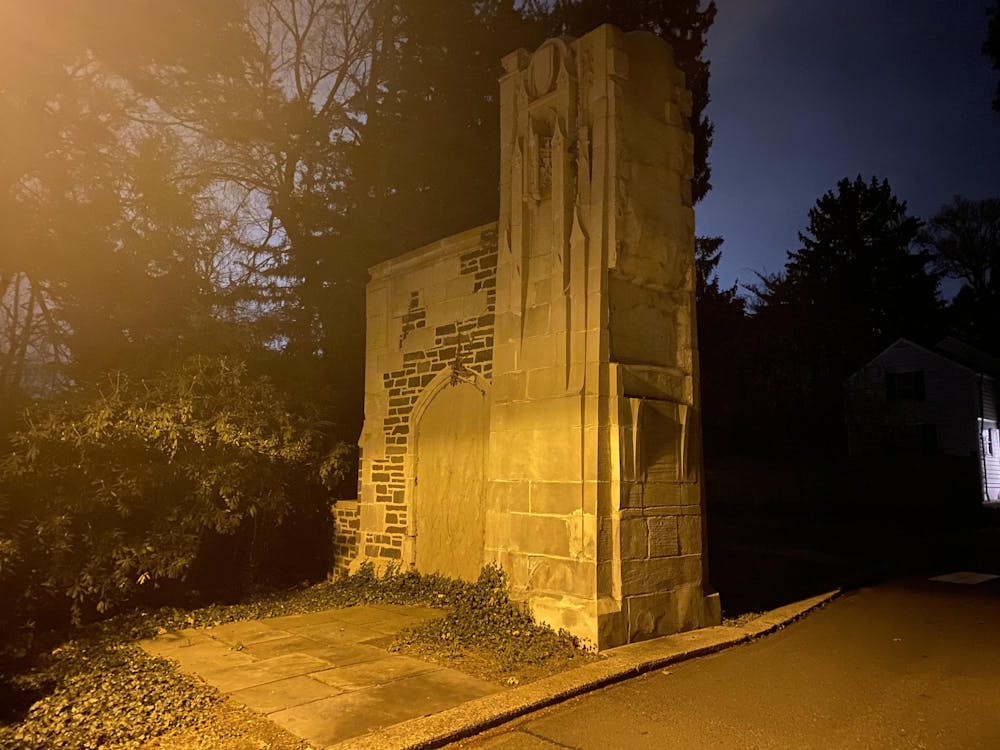The University will relocate the historical Eisenhart Arch on the western side of the Graduate College, moving the structure roughly 50 feet to the left. At the Nov. 14 meeting of the Princeton Planning Board, the group approved the project for spring 2025 pending approval from regulatory agencies.
In a statement to The Daily Princetonian, University spokesperson Jennifer Morrill wrote that the project, which also includes raising the arch by two feet, “is expected to take approximately one year.”
In the meeting, Grant Peatman, project manager at the University, explained what this project will entail for the community once started.
“We will have to close the road down for several weeks in the beginning to deconstruct the arches. We will open it up as we reevaluate. When we have favorable weather, we will have to close the road down for about six months,” Peatman said.
Currently, both vertical supports of the arch are still standing, but without a connecting crown. While multiple trucks have bumped into the arch, the pillars managed to avoid severe damage until the 2003 accident when a tractor-trailer, making the tight turn onto New College Road, crashed into the arch. According to Morrill, the project has been on the University Facilities Organization’s list of anticipated maintenance projects since then. The planned relocation of the arch aims to prevent future accidents of this kind.
After the damage, the University worked to preserve as many original pieces of stone as possible by keeping them in a storage yard. University architect Ron McCoy told the planning board committee at the meeting, “Each stone has been labeled and identified and we know we are going to reuse everything that can be reused.”
“We’ve done everything we can to preserve all the stones available to us,” he added.
The Eisenhart Arch was designed by Charles Klauder in 1931 and was originally located where the Dodge Gates now stand at the southern entrance to Henry Courtyard. In response to student complaints that the arch was blocking other architecture on campus, Princeton Facilities removed it. In 1951, the arch was relocated to the Graduate College, named in honor of Princeton mathematician, professor, and dean Luther P. Eisenhart.
In a statement to the ‘Prince,’ Jonathan Victor Baldoza GS wrote, “I remember passing through what was left of that Arch in walks or whenever I would bike from the Graduate College to the Institute Woods. It was a curious sight, like a gate in the form of ruins.”
The anticipated reconstruction of the arch will come with a few changes. It will now have granite wheel guards, which are protective measures placed on the bottom of the arch that prevent trucks from getting too close. According to McCoy, the wheel guards failed to be included in the 1950 construction of the arch, which ultimately caused the 2002 accident.
The arch is also a roadblock for many cars trying to turn at the Springdale and College Road intersection, obstructing their view and serving as a hazard toward pedestrians crossing the street. To address this, Morrill explained that the arch will be located 50 feet to the east of its original position, in order to allow “trucks to complete a turn and fully align with the archway, providing safe clearance.”
McCoy also explained to the planning committee that the arch’s height will be raised approximately two feet so the largest trucks on New Jersey roads can comfortably drive through.

When asked about support for the project, Morrill wrote, “We had positive feedback from the Princeton Planning Board and neighbors who live proximate to the arch.”
Town resident Felicia Spitz told the Planning Board, “In my house, we call this the scary street. In order to see out to the intersection, they [the cars] pull out very far and very quickly. The sidewalk is on that side of the road, and my son was always scared to cross the street.” She proceeded to support the project, thanking the University for moving the arch further back.
Planning Board member Derek Bridger added, “I was just starting my tenure at the town when they removed the arch, and I was not so sure if it would be replaced, but I’m very happy they followed through.”
Even though this arch is a historical feature of the graduate college, some graduate students were not aware of the reconstruction project. Chenchen Yan GS, who studies the theory of architecture, wrote in a statement to the ‘Prince,’ “I think the Arch seems so disconnected from the Grad College that it doesn’t function like a monumental entryway anymore. It always feels like a strange presence to me, and it certainly upsets lots of drivers because it really blocks the view when one turns onto Springdale/College Rd W.”
McCoy told the Planning Board, “This is a small project that we’ve been working on for the last 93 years. We hope … we are confident, we are going to get it right this time.”
Kimberly Vasta is a News contributor for the ‘Prince.’
Please send corrections to corrections[at]dailyprincetonian.com.








